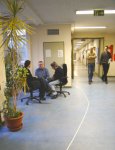 |
 |
|||||||||||||
|
|||||||||||||
|
|||||||||||||
|
People with big plans need time and space to make their dreams come true – assuming that they already have some money to get going. The time for the European-funded linear collider R&D consortium EUROTeV was almost up. Together with the CALICE collaboration, they were making plans for a virtual control room for next spring that would let them manage the experimental setup sitting in a testbeam at Fermilab remotely from a partitioned-off section of a corridor at DESY. This plan, along with many other tasks and plans run and made by EUROTeV people, is now reality: the European Commission extended the project by another year.
EUROTeV is a collaboration of 28 European universities and research laboratories. It has driven R&D topics for both the International Linear Collider and the Compact Linear Collider (CLIC) for three years and contributed R&D results to the Reference Design Report. In 2005, EUROTeV received nine million Euros from the European Commission, and labs and institutes contributed another 18.5 million. All together the funding formed a European collaboration in the field of accelerators in areas such as beam delivery, damping rings, positron source, beam dynamics and stabilisation. Development of beam instrumentation is of interest both for CLIC and the ILC, and new diagnostics tools have already been used at ATF (KEK), CTF III (CERN), ESA (SLAC) and PETRA (DESY). “We have been charged by the ILC Project Management to continue to work on the ILC in the engineering design phase. With the project extension this will be much easier,” says Eckhard Elsen, EUROTeV coordinator. “Member institutes of EUROTeV have taken the ILC coordination role for the damping rings and for the positrons source. It thus comes as a very pleasant surprise that the European Commission granted an extension of the project till the end of 2008. This will enable us to use the entire EC grant, actually complemented by institutional contributions, and thus help to fulfill the European role in the engineering design phase.” One of the planned efforts that extended beyond the funding period is the global accelerator network (GAN). Almost two years ago, they successfully injected beams into the Italian laboratory ELETTRA from a remote office at DESY, which means that GAN works and can lead to the first applications. After testing the calorimeters, tailcatcher and muon tracker at CERN last summer, the CALICE collaboration plans the next round of tests in the beam at Fermilab. In order to avoid nightshifts (and save on travel expenses), a control room will be set up with the help of the EUROTeV GAN people and colleagues from Fermilab. The additional control room at DESY will give run coordinators in the US a good night's sleep and ensure best possible data collection. A section of corridor at DESY is already marked as the future control room. Looking ahead, another main European ILC effort is the required accelerating gradient, which is being negotiated with the EC in form of the ILC-HiGrade programme. EUROTeV institutes may form part of a larger effort in the context of future infrastructure programmes where the designs developed could be put to test. If successful, the funding for that effort could start in 2009 - well matched to the completion of the EUROTeV programme. -- Barbara Warmbein |
|||||||||||||
| © International Linear Collider |
